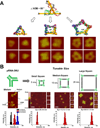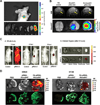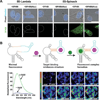RNA as a stable polymer to build controllable and defined nanostructures for material and biomedical applications
- PMID: 26770259
- PMCID: PMC4707685
- DOI: 10.1016/j.nantod.2015.09.003
RNA as a stable polymer to build controllable and defined nanostructures for material and biomedical applications
Abstract
The value of polymers is manifested in their vital use as building blocks in material and life sciences. Ribonucleic acid (RNA) is a polynucleic acid, but its polymeric nature in materials and technological applications is often overlooked due to an impression that RNA is seemingly unstable. Recent findings that certain modifications can make RNA resistant to RNase degradation while retaining its authentic folding property and biological function, and the discovery of ultra-thermostable RNA motifs have adequately addressed the concerns of RNA unstability. RNA can serve as a unique polymeric material to build varieties of nanostructures including nanoparticles, polygons, arrays, bundles, membrane, and microsponges that have potential applications in biomedical and material sciences. Since 2005, more than a thousand publications on RNA nanostructures have been published in diverse fields, indicating a remarkable increase of interest in the emerging field of RNA nanotechnology. In this review, we aim to: delineate the physical and chemical properties of polymers that can be applied to RNA; introduce the unique properties of RNA as a polymer; review the current methods for the construction of RNA nanostructures; describe its applications in material, biomedical and computer sciences; and, discuss the challenges and future prospects in this field.
Keywords: Biopolymer; RNA nanostructure; RNA nanotechnology; RNA therapeutics; pRNA; phi29 DNA packaging motor.
Figures








References
-
- Carraher CE. Carraher’s Polymer Chemistry. ninth. mCRC Press, FL; 2013.
-
- Tsenoglou C. Macromolecules. 1991;24:1762–1767.
-
- Cassagnau P, Montfort JP, Marin G, Monge P. Rheol. Acta. 1993;32:156–167.
-
- Badi N, Lutz JF. Chem. Soc. Rev. 2009;38:3383–3390. - PubMed
-
- Lehn JM. Polym. Int. 2002;51:825–839.
Grants and funding
LinkOut - more resources
Full Text Sources
Other Literature Sources
